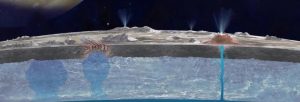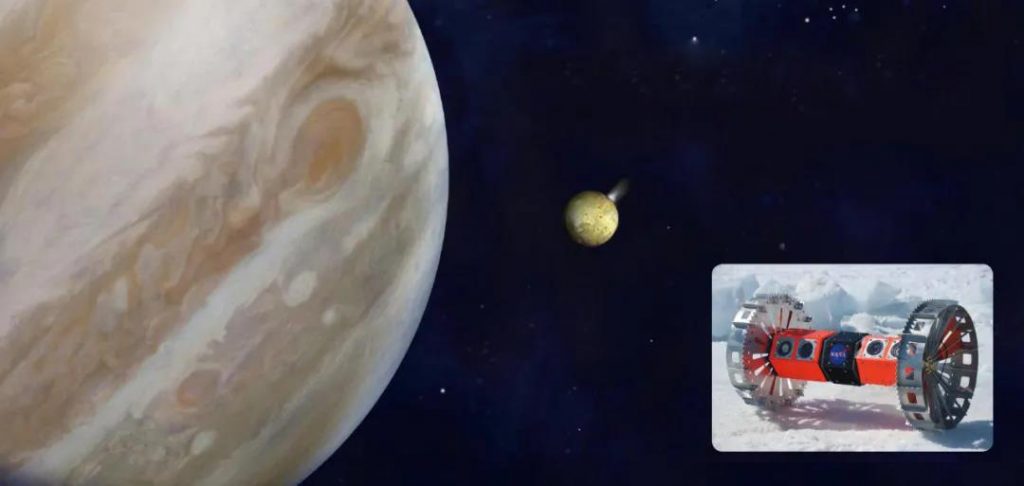
Somewhere in the Antarctic ice, there is a large hole with a diameter of 183 cm. There are 6 NASA scientists standing next to the hole. They are operating something. They are not studying the underwater environment of Antarctica this time, but are testing an underwater probe called “BRUIE” (Buoyant Rover for Under-Ice Exploration).

Why did they travel all the way to the Antarctic ice continent for testing? Because this underwater probe is not easy, scientists hope that it will be able to go to Europa in the future to search for extraterrestrial life in the “ocean” under Europa’s “ice crust”.
Before we learn more about the BRUIE underwater probe, let us briefly understand Europa.
“Water Moon” Europa
Europa’s diameter is about 3,100 kilometers, slightly smaller than the moon’s 3,500 kilometers. In 1990, NASA launched the Galileo satellite probe to Europa. By studying relevant data, scientists suspect that Europa’s surface is likely to have a large amount of liquid water.
An important basis is that scientists have observed a scene similar to a large water vapor plume on Europa; in addition, Europa is the smoothest celestial body known in the solar system, and Europa has the lowest surface temperature of -223. ℃, the highest is -148℃, which means that Europa’s surface is very likely to have formed a thick layer of ice.
But since the water is frozen, where do you start with liquid water? Because scientists have measured that the tidal force on Europa is 1,000 times that of the earth, the tidal heating caused by this level of tidal force is enough to keep the “ocean” under the ice liquid, and it is this tidal force that “tipped apart”. “The ice surface makes a large amount of warmer water rush to the surface, and then it becomes cold to form a large plume of water vapor.

Scientists used this theoretical conjecture and collected data to build a model that successfully predicted a large water vapor plume on Europa in September 2016. According to model predictions, the amount of liquid water on Europa is likely to be three times that of the earth, and the warm ocean indicates that it may still have life. This has given scientists enough motivation to try their best to explore Europa in more depth. The BRUIE was born.
BRUIE strolling under the ice
The structure of the BRUIE is very simple: a one-meter-long cylinder is connected to two large wheels at both ends to facilitate driving under the ice. The cylinder is divided into two sections, each section can be independently rotated up and down, and is equipped with its own camera and lighting.
The reason why BRUIE has such a structure is that it can not only float in the ocean, but also sink into the seabed, and it can also reduce unnecessary braking as much as possible, reduce energy loss, and reduce BRUIE’s Possible life threats to microorganisms under the ice. Scientists don’t hope that in the future, the BRUIE will take away these tiny lives as soon as it comes into contact with alien life.
When the BRUIE was close to the bottom of the ice, it officially began to work. At this time, it will slowly move forward and shoot images with a camera.
This is not the final form of the BRUIE. After all, the environmental conditions in the places where it will go will be more severe. The energy of the BRUIE has always been a headache for scientists. If the surface of Europa is okay, BRUIE can use the sun to supplement energy, but once the BRUIE goes down to the ocean under the ice, it will not know when and how long it will be able to return. To the “ground”, let alone before that, it has to find a way to penetrate 30 kilometers of ice.
Scientists have thought of a solution, that is, the future BRUIE will be driven by nuclear energy, and then use the heat generated by nuclear energy to melt the ice, and at the same time, the BRUIE will push itself through the ice.
Fortunately, there is still some time before the official departure of BRUIE. Scientists will launch a probe called Europa Clippers in 2025.
The probe will conduct at least 40 rounds of Europa. Probe, collect data for further probes, and then decide on the itinerary of the BRUIE number. During this time, scientists seem to have plenty of time to solve the BRUIE’s most important energy problem.
Is there any liquid water and life on Europa? What will the BRUIE accomplish in the end? In the near future, we will know the answers to these questions.
Comments